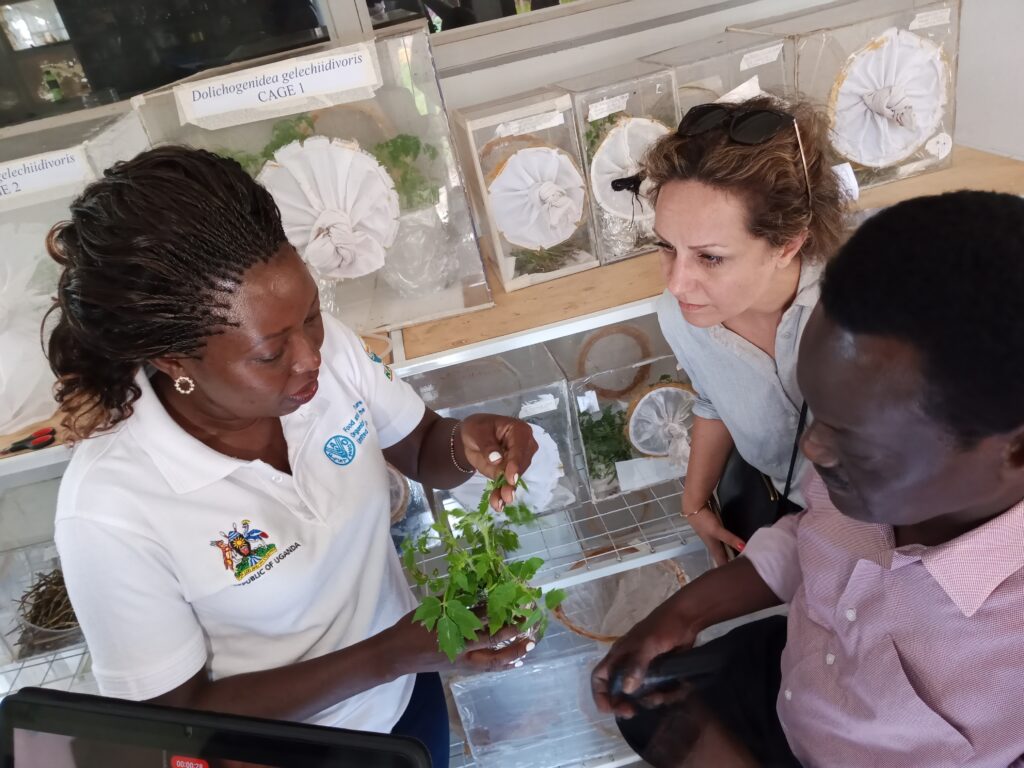By Prossy Nandudu
In an effort to reduce the use of agrochemicals in the food value chain, scientists at the National Agriculture Research Laboratories (NARL) in Kawanda have developed biological control measures.
These are expected to help farmers get rid of weeds on land and in water.
The control measures are also expected to protect fish in water bodies against water weeds and crops against weeds and pests; protect animals which would feed on weeds sprayed with agrochemicals and those that would eat poisonous weeds and die.
This was revealed by Winnie Aol Opio, an entomologist with NARO, while taking around a team from the Intergovernmental Authority on Development and the Food and Agriculture Organization of the United Nations. The team wanted to understand the progress being made by researchers in Uganda in relation to transboundary disease and pest management, at Kawanda in Wakiso district recently.
Aol said the initiative will not only reduce the use of agrochemicals in food items, but will also prepare Ugandans for chemical-free agriculture exports.
According to Aol, the European Union has issued a warning that by 2050, there will be zero tolerance for pesticide use in agriculture production.
“And now that the EU is targeting that by 2050, there will be no use of pesticides the world over, there is a need to start looking for alternatives. This brings in the biological controls that we are talking about,” said Aol.
Progress in the management of the fall armyworm
Opio explained that for the fall armyworm, they have identified organisms that feed on the eggs and the larvae thereby preventing reproduction.
She adds that in the process, the populations reduce beyond economic concerns, an example is that where there are about 100 fall armyworms, the population is able to reduce to about 10 worms that have no economic importance and don’t need the application of any control measure like the pesticides.

Kaliba weed on Lake Kyoga
For the Salvinia weed, also known as Kaliba or Nankabirwa weed, Opio said they have introduced the Salvinia weevil into Lake Kyoga, the weevils depend on the weed as their food, when the weed is done, these will eventually die and disappear.
Tomato pests
For the tomato Pest called Tuta absoluta, which burrows itself into the fruit destroying it from the inside, leading to hardening and eventually rotting; Opio explained that they have two biological control measures, one using a Wasp that also targets the lavea, killing it before any reproduction takes place.
And the other which is now commercially available is the use of Pheromone traps. The traps have been coated with a sticky substance that smells like a female tuta.
These attract the male tuta, and when they land on the trap, they are trapped on the sticky part, and eventually die. With such a trap the male population is destroyed, rendering females nonproductive. The traps have so far been distributed to farmers in Kamuli, Namutumba and Masaka districts.
Securing livestock feeds
For livestock, she explained that they have a solution to the invasive Congress or Parthenium weed is a beetle, of which a pair of beetles can destroy one plant in eight days. The beetles eat the leaves and flowers of the plant, cutting short their reproduction cycle.
The dangers of these weeds are that when eaten, it kills, especially wildlife and that they have so far received reports from Queen Elizabeth National Park of deaths among elephants after eating the congress weed.
Apart from causing death, the congress weeds affect the reproduction of other weeds in places where it establishes itself, hence denying all animals that feed on grass including cows’ food, Opio explained.
“So our efforts now to multiply the beetles as much as possible to eat up the congress weed in the park as opposed to spraying as the chemicals could affect other lives in the game parks,” Opio added
Where have they worked?
She added that some of the solutions being implemented in Uganda have already worked in S. Africa, Ethiopia, Tanzania, Australia and Kenya is the final process of getting the beetles to also fight the same weed (congress weed).
Despite the progress in research, Opio said the ongoing research is hinged on funding from development partners, which she said is not sustainable.
“Most of the work we do is funded by donors, donor-funded projects are time bound. The projects are also geographical and don’t cover the whole country, so there is now need to upscale the technologies but we lack the funds,” she added.
Commenting on the progress, Kenneth Mwangi from the Climate Prediction and Applications Centre at IGAD said the research is part of IGAD’s effort to build capacity among member countries to manage transboundary pests and diseases.
How safe are they to the environment?
Orlando Sosa an agriculture officer at FAO’s sub regional office based in Ethiopia however assured the farming community that the use of living organisms is done after care selection and studies about the biology of control agents.
Adding that solutions for controlling the pest in Uganda have been found to be so specific to the target pest that after destroying its agent, it cannot survive.
“So we are promoting these approaches, one of the things to underscore when using these, it is not just released, there is background work to ensure it is safe for the environment, health and crops as well.





